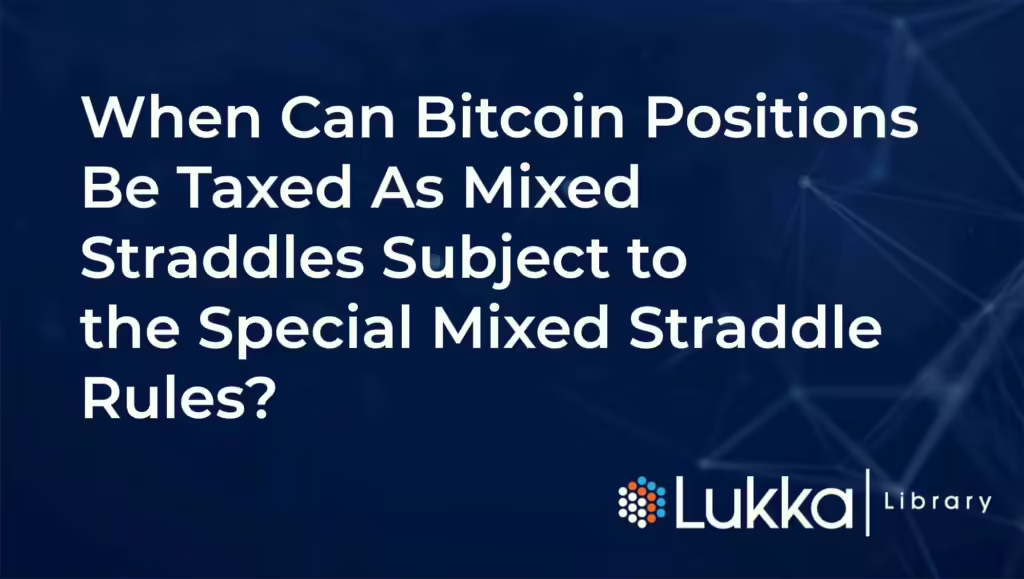
Author: Andrea S. Kramer, McDermott Will & Emery*
The discussion in this document reflect legal principles as of February 29, 2020.
Taxpayers often enter into offsetting long and short transactions to minimize risk, defer tax, and convert long-term and short-term capital gain and loss to maximize the possible benefits of tax rate differentials. Particularly onerous tax consequences can result if taxpayers enter into offsetting positions where one— but not all—of the positions making up a straddle are taxed as section 1256 contracts while another offsetting position is not a section 1256 contract. Taxpayers who enter into certain virtual currency transactions can be subject to the adverse consequences of holding mixed straddles and need to understand ways they can minimize or avoid these consequences.
Taxpayers who do nothing—whether intentionally or inadvertently—are subject to the “killer rule,” which applies to convert short-term loss from a non-section 1256 position to 60/40 loss.1 Short-term gain offset by 60/40 losses are left unchanged. The killer rule “converts” only one way—in the government’s favor—and it is a “killer” to any taxpayer with a substantial volume of mixed straddles.2 This one-way conversion typically has a punitive tax effect.
Taxpayers who hold positions in Bitcoins and Bitcoin futures or options traded on the Chicago Mercantile Exchange (CME) can be subject to the mixed straddle rules if they hold straddles where not all of the positions are in CME futures or options. For background reading on the straddle rules and section 1256 treatment, see McDermott’s Memoranda, “When Virtual Currency Positions are Subject to the Straddle Rules” and “Special Tax Rules Apply to Bitcoin Futures and Options and Might Apply to Positions in Other Virtual Currencies in the Future.” This Memorandum discusses the tax rules for mixed straddles, that is, straddles that consist of both section 1256 contracts and non-section 1256 contracts.
Overview of Straddle Rules
A tax straddle exists when a taxpayer holds two or more positions in personal property when one or more of the positions substantially diminishes the risk of loss with respect to another position.3 Virtual currency positions are subject to the tax straddle rules if the virtual currency is actively traded personal property and the positions are offsetting.4 The straddle rules require deferral of losses on an offsetting position until the gain positions are closed out.
Convertible virtual currency is “property” for tax purposes, and the IRS applies general tax principles to transactions in virtual currency.5 Because Bitcoins have an equivalent value in actual currency, can be substituted for actual currency, are traded on an established on-line market, and can be purchased for or exchanged into U.S. dollars or other actual or virtual currencies, it is likely that Bitcoins are subject to the straddle rules.
Mixed Straddles
A tax straddle is a mixed straddle if one or more of the positions in the straddle is a section 1256 contract and the other positions are not section 1256 contracts.6 If a taxpayer holds CME Bitcoin futures or options as well as other Bitcoin positions, the taxpayer probably holds a tax straddles that may be subject to the mixed straddle rules. Because section 1256 contracts are subject to 60/40 tax treatment while non-section 1256 positions are subject to short-term capital gain or loss, taxpayers could have an incentive to use mixed straddles to convert short-term capital gain into 60/40 gain. Congress enacted the mixed straddle rules to prevent such a tax conversion.
Why Special Rules Were Needed
In the absence of the mixed straddle rules, taxpayers could generate short-term loss in a non-section 1256 contract position and an offsetting 60/40 gain in a section 1256 contract. The short-term loss could then be used to mop-up unrelated short-term gain (leaving the taxpayer with only long-term capital gain). The mixed straddle rules prevent taxpayers from doing this. They also prevent taxpayers from reporting 60/40 gain or loss on section 1256 contracts and (depending on the taxpayer’s holding period) 100 percent short-term or long-term capital gain or loss on their non-section 1256 positions.7
Choices Available When Holding A Mixed Straddle
Taxpayers with mixed straddles essentially have four choices if they want to avoid the killer rule:
- Elect Out of I.R.C. § 1256. A taxpayer can make a one-time section 1256(d) identified mixed straddle election that removes the section 1256 contracts in the straddle from section 1256 treatment. The mixed straddle remains subject to the straddle rules, and if the taxpayer does not properly identify all of the positions making up the mixed straddle, special rules convert short-term capital loss to 60/40 loss when offset by a 60/40 gain. Interest and carrying charges incurred to carry a mixed straddle position must also be capitalized.
- Make an “Identified Straddle Identification.” If a taxpayer’s mixed straddle qualifies as an identified straddle under I.R.C. § 1092(a)(2), the taxpayer can designate the straddle as an “identified straddle.” Instead of deferring straddle losses, the taxpayer must adjust the tax basis on the gain position to reflect the nondeductible straddle losses.8 Interest and carrying charges incurred to carry the mixed straddle must also be capitalized.
- Straddle-by-Straddle Identification. A taxpayer can identify a mixed straddle using “straddle by-straddle” identification under I.R.C. § 1092(b)(2). With straddle-by-straddle identification, the taxpayer nets all gains and losses on the mixed straddle. In addition, the taxpayer must defer recognition of pre-straddle gain or loss on any of the positions that had been open before the straddle was established9 under Treasury Regulation § 1.1092-6T.10 The straddle rules still apply after the taxpayer makes the required computations.11
- Establish a Mixed Straddle Account. A taxpayer with a large number of mixed straddles can establish a mixed straddle account for each class of activities, with gains and losses recognized and offset on a periodic basis. In setting up a mixed straddle account, the taxpayer must carefully determine which positions qualify as a particular “class of activities.” It is not likely, for example, that a straddle account including Bitcoins could properly include other virtual currencies. The convenience of a mixed straddle account is offset by a tax cost which effectively functions as a toll charge. Not more than 50 percent of any net gain derived from positions in the account (whether or not otherwise qualified for section 1256 treatment) can be treated as long-term capital gain, while not more than 40 percent of any net loss can be treated as short-term capital loss.12
Taxpayers should avoid the killer rule by selecting one of the mixed straddle choices set out in this Memorandum. Doing nothing is never a recommended way to proceed because of the killer rule. Loss on a non-section 1256 contract can be converted under the killer rule to 60/40 loss without also converting section 1256 contract losses to short-term capital losses. A taxpayer with a mixed straddle that produces a loss on the section 1256 contract position, a short-term gain on the non-section 1256 contract position, and a long-term capital gain from sources unrelated to the straddle will convert long-term capital gain to short-term gain.13 The Treasury cannot impose the killer rule on positions other than those making up a mixed straddle.14
Taxpayers should, on a regular basis (at least annually), carefully determine whether there is an established market for the virtual currencies they hold, therefore, potentially subjecting their positions to the straddle rules. Next, they should determine whether they hold offsetting positions in those virtual currencies. And, if they hold both section 1256 contracts and non-section 1256 contracts, they need to evaluate whether those straddles are mixed straddles subject to the special rules that apply only to mixed straddles.
Taxpayers who believe they might hold mixed straddles should consult with their tax advisors to assure that they properly report federal and state tax. Many states do not follow the federal tax Code in computing state taxes.
* This material is for general information purposes only and should not be construed as legal advice or any other advice on any specific facts or circumstances. No one should act or refrain from acting based upon any information herein without seeking professional legal advice. McDermott Will & Emery makes no warranties, representations, or claims of any kind concerning the content herein. McDermott and Andrea S. Kramer expressly disclaim all liability to any person in respect of the consequences of anything done or not done in reliance upon the use of contents included herein. For a complete list of McDermott entities, visit mwe.com/legalnotices.
©2020 McDermott Will & Emery. All rights reserved. Any use of these materials including reproduction, modification, distribution or republication, except as part of the Lukka Library is strictly prohibited without the prior written consent of McDermott. This material may be considered attorney advertising. Prior results do not guarantee a similar outcome.
1 See Temp. Treas. Reg. § 1.1092(b)-2T(b)(2) (1986).
2 The killer rule can be avoided by making the separate section 1092(b)(2) straddle-by-straddle identification election or the mixed straddle account election.
3 I.R.C. § 1092(d)(1).
4 I.R.C. § 1092(a)(1); Treas. Reg. §§ 1.1092(b)–1T and –2T.
5 Notice 2014-21, Q&A-1.
6 I.R.C. § 1256(d)(4)(A).
7 See Staff of the Joint Comm. on Taxation, 98th Cong., 2d Sess., General Explanation of the Revenue Provisions of the Deficit Reduction Act of 1984, at 304 and 316-17 (Joint Comm. Print 1984).
8 T.D. 9678, 2014-32 I.R.B.
9 T.D. 9627 (Doc 2013-18683)
10 Announcement 2013-45; 2013-47 I.R.B. 546.
11 Temp Treas. Reg. §1.1092(b)-3T(c) (1985)
12 Temp. Treas. Reg. § 1.1092(b)-4T(c)(4) (1985).
13 See House Conference Report, Deficit Reduction Act of 1984, H.R. Conf. Rep. No. 861, 98th Cong., 2d Sess. 912 (1984).
14 Arrow Fastener Co. v. Comm’r, 76 T.C. 423, 431 (1981); Koshland v. Helvering, 298 U.S. 441, 447 (1936), rev’g 81 F.2d 641 (9th Cir. 1936).



